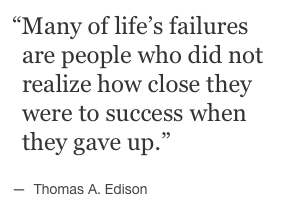This blog has frequently stated that a successful learning culture must accept that failures are an important component of learning.
So what, exactly, does that mean?
Does this mean that managers are to overlook mistakes and praise and reward those who’ve screwed up?
Wouldn’t the end result of such behavior be an organization whose members were sloppy, inaccurate and imprecise in their work?
What, specifically, would an organization interested in making a shift from the “push” training culture to a “pull” learning culture do if it wanted to make failure an opportunity to learn about problems before it grew too expensive –or too late — to address and correct them?

These are all important questions — and I’ll talk about them in this and a series of blogs to follow. But let me start by quoting Amy C. Edmondson, the Novartis Professor of Leadership and Management at the Harvard Business School who states, “All failures are not created equal.”
In her highly engaging and readable article, Strategies for Learning from Failure published in the Harvard Business Review, Edmondson illustrates how some failures can provide highly valuable information, while others are inherently less helpful.
Edmondson has divided failure into the following three categories for which I have provided abbreviated descriptions, which are based largely on hers:
Preventable failures in predictable operations
These are failures most of us would consider “bad.” As Edmondson states, “They usually involve deviations from spec in the closely defined processes of high-volume or routine operations in manufacturing and services. With proper training and support, employees can follow those processes consistently. When they don’t, deviance, inattention, or lack of ability is usually the reason. But in such cases, the causes can be readily identified and solutions developed.”
Think of the famous Toyota Production System, which instills in all employees the importance of pulling a rope to stop the assembly line immediately upon spotting — or even suspecting –there is a problem. Diagnostics and problem-solving process kick in, and there is no “punishment” for initiating this process, which over the years, has helped the company identify real and potential problems early, before they became serious, system-wide, and costly to the company and its reputation.
Unavoidable failures in complex systems
This relates to work involving “a particular combination of needs, people, and problems may have never occurred before,” as Edmondson puts it. Some examples of this type of work includes healthcare professionals in hospital emergency rooms, soldiers in battle, people working in nuclear power plants
Even if workers follow best practices for safety and risk management, small process failures will occur. Often, true disaster is caused by a series of small failures that occurred within a short period of time, or occurred in a particular sequence. To prevent this, workers need to feel they will be supported — not stigmatized — when they report small failures with equipment, systems or procedures while it is possible to address and correct them, rather than waiting until a true crisis — or disaster –occurs.
Intelligent failures at the frontier
The term “intelligent failures” was coined by Duke University professor of management, Sim Sitkin. Dr. Edmondson defines these as “good” failures that “occur in environments where answers are not knowable in advance because this exact situation hasn’t been encountered before and perhaps never will be again.”
Intelligent failures are to be expected in companies working to create a new vaccine, build a new type of aircraft or vehicle. In these situations, good work involves good experimentation– and it is always hoped that the failures good experimentation will produce will be quick and decisive. If they are, they will prevent the organization from sinking further time, money and other resources into unproductive work.
There you have it: the hierarchy of organizational failure as laid out by one of the finest minds at Harvard Business School.
My next blog will consider the reasons why organizations are so resistant to the idea of “destigmatizing failure.”
KnowledgeStar is a corporation that consults with large and small organizations to transform themselves into learning cultures. Contact us at David(at)KnowledgeStar.(com)
Posted in Advancement, Continuous Learning, corporate training, Education, Formal Learning, Learning, Training & Development | Tagged Amy C. Edmondson, failure,Harvard, intelligent failure, Learning, Learning Culture, Organizational psychology, Prof. Edmondson, training, training & Development | Leave a Comment »

This post written by Susan Fry and David Grebow
“Push” learning has gone the way of the cassette tape, tube television and electric typewriter.
Leading educators and trainers now regard push learning as inefficient, suboptimal and outdated. Even many schools, often the slowest institutions to change, are rapidly making the transition away from that model.
Yet, despite the fact that “push learning” is clearly not suited for today’s “economy of ideas,” corporations have been surprisingly reluctant to make the necessary change.
Why?
The reason may well lie in the fact that a “pull” learning culture is truly democratic. It’s a culture that encourages and supports everyone to explore and demonstrate their initiative and abilities, allowing the best to rise to the top based on merit.
That sounds like a great benefit to any organization. But when put into practice, the concept can prove to be quite revolutionary.
Throughout history, providing access to knowledge has been a way to control who gained power, wealth and status.
Learning and training are often hoarded and carefully doled out to people upon whom top management wish to confer success. Often, they are golden keys to elite private club that are given to friends’ children, colleagues, and clients, alumni from the same university, people of the same culture, class or color.
There can be no doubt that in the last 50 years, countries with the world’s leading economies have worked to erode discrimination and provide greater employment opportunities to people regardless of their race or gender.
It’s time organizations make another much-needed cultural shift, and “tear down the wall” by replacing the old, “push” learning culture with a “pull” culture that ensures equal opportunity learning.
KnowledgeStar is a corporation that consults with large and small organizations to transform themselves into learning cultures. Contact us at David(at)KnowledgeStar.(com)
Posted in Advancement, Continuous Learning, corporate training, Education, Formal Learning, Learning, Training & Development | Tagged Amy C. Edmondson, failure,Harvard, intelligent failure, Learning, Learning Culture, Organizational psychology, Prof. Edmondson, training, training & Development | Leave a Comment »

This post written by Susan Fry and David Grebow
“Push” learning has gone the way of the cassette tape, tube television and electric typewriter.
Leading educators and trainers now regard push learning as inefficient, suboptimal and outdated. Even many schools, often the slowest institutions to change, are rapidly making the transition away from that model.
Yet, despite the fact that “push learning” is clearly not suited for today’s “economy of ideas,” corporations have been surprisingly reluctant to make the necessary change.
Why?
The reason may well lie in the fact that a “pull” learning culture is truly democratic. It’s a culture that encourages and supports everyone to explore and demonstrate their initiative and abilities, allowing the best to rise to the top based on merit.
That sounds like a great benefit to any organization. But when put into practice, the concept can prove to be quite revolutionary.
Throughout history, providing access to knowledge has been a way to control who gained power, wealth and status.
Learning and training are often hoarded and carefully doled out to people upon whom top management wish to confer success. Often, they are golden keys to elite private club that are given to friends’ children, colleagues, and clients, alumni from the same university, people of the same culture, class or color.
There can be no doubt that in the last 50 years, countries with the world’s leading economies have worked to erode discrimination and provide greater employment opportunities to people regardless of their race or gender.
It’s time organizations make another much-needed cultural shift, and “tear down the wall” by replacing the old, “push” learning culture with a “pull” culture that ensures equal opportunity learning.
KnowledgeStar is a corporation that consults with large and small organizations to transform themselves into learning cultures. Contact us at David(at)KnowledgeStar.(com)
Posted in Advancement, Continuous Learning, corporate training, Education, Formal Learning, Learning, Training & Development | Tagged Amy C. Edmondson, failure,Harvard, intelligent failure, Learning, Learning Culture, Organizational psychology, Prof. Edmondson, training, training & Development | Leave a Comment »

This post written by Susan Fry and David Grebow
“Push” learning has gone the way of the cassette tape, tube television and electric typewriter.
Leading educators and trainers now regard push learning as inefficient, suboptimal and outdated. Even many schools, often the slowest institutions to change, are rapidly making the transition away from that model.
Yet, despite the fact that “push learning” is clearly not suited for today’s “economy of ideas,” corporations have been surprisingly reluctant to make the necessary change.
Why?
The reason may well lie in the fact that a “pull” learning culture is truly democratic. It’s a culture that encourages and supports everyone to explore and demonstrate their initiative and abilities, allowing the best to rise to the top based on merit.
That sounds like a great benefit to any organization. But when put into practice, the concept can prove to be quite revolutionary.
Throughout history, providing access to knowledge has been a way to control who gained power, wealth and status.
Learning and training are often hoarded and carefully doled out to people upon whom top management wish to confer success. Often, they are golden keys to elite private club that are given to friends’ children, colleagues, and clients, alumni from the same university, people of the same culture, class or color.
There can be no doubt that in the last 50 years, countries with the world’s leading economies have worked to erode discrimination and provide greater employment opportunities to people regardless of their race or gender.
It’s time organizations make another much-needed cultural shift, and “tear down the wall” by replacing the old, “push” learning culture with a “pull” culture that ensures equal opportunity learning.
KnowledgeStar is a corporation that consults with large and small organizations to transform themselves into learning cultures. Contact us at David(at)KnowledgeStar.(com)


